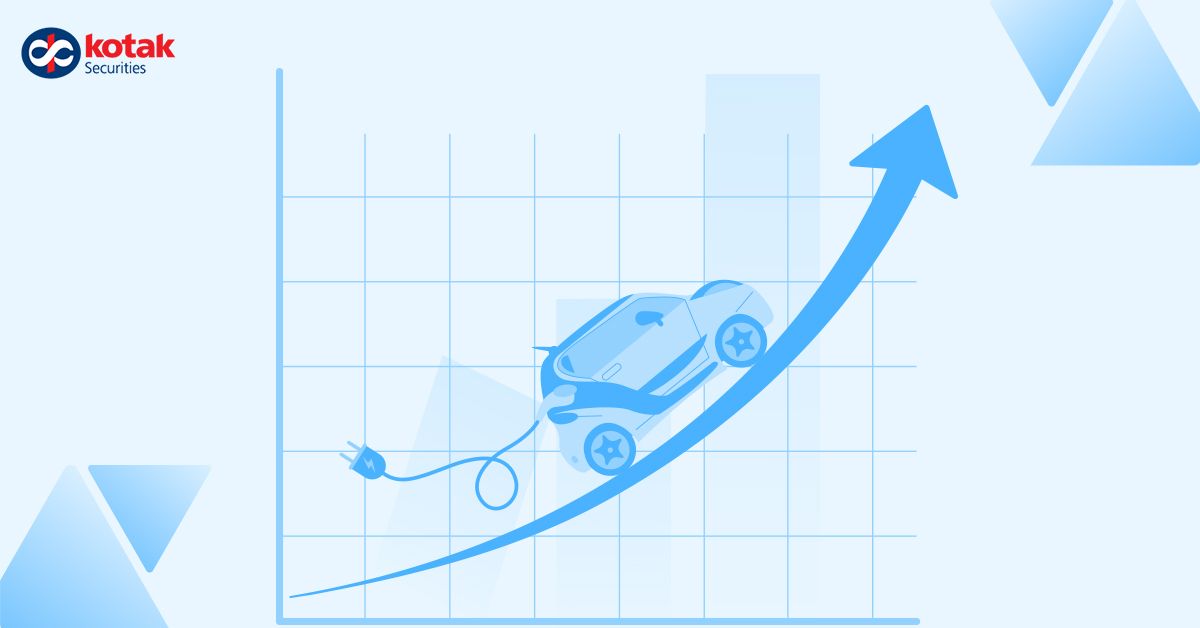India's EV Revolution and Is It Here to Stay?
Kotak Insights | Date 03/05/2024
Remember the movie scene where the hero jumps in a sleek car and zooms off into the sunset?
Well, swap that traditional gas guzzler with an electric vehicle (EV), and that’s what’s happening in India right now.
In FY24, the electric vehicle market in India saw a staggering surge in sales, marking a 91% increase in electric passenger vehicles from the previous year. According to the Federation of Automobile Dealers Associations (FADA), sales reached a new high of 90,996 units.
That's a booming shift towards electric mobility in India.
So, what is fuelling this growth?
Let us understand this and learn about the sector’s challenges to answer if the EV revolution will continue its momentum.
What's Fuelling the EV Boom in India?
Let's break it down:
Government Incentives Drive Adoption
The government's been offering sweet deals on EVs through schemes like FAME-II, making them way more affordable than their gasoline-powered counterparts. This reduces the cost barrier significantly compared to traditional fuel vehicles. Launched in 2019, FAME II has so far subsidised sales of nearly 1.3 million two-wheelers, 150,613 three-wheelers, and 18,794 four-wheelers.
So, these incentives drive consumers to choose more sustainable and environmentally friendly transportation options. Think of it as a green light for eco-friendly rides.
Enhanced Policy Support
Beyond subsidies, the government has introduced several additional measures to accelerate EV adoption. These include substantial tax breaks and streamlined registration processes for electric vehicles, effectively rolling out the red carpet for them.
The government recently also announced a new scheme called the Electric Mobility Promotion Scheme (EMPS), 2024. This scheme aims to promote sale of electric two and three wheelers in India and the government has allocated Rs 500 crore towards this.
This scheme will offer a subsidy on EVs of up to Rs 10,000 per two-wheeler, Rs 25,000 per light three-wheeler (like e-rickshaws), and Rs 50,000 per heavy three-wheeler (like autos and commercial units).
That’s a sweet deal, isn’t it?
Expanding Vehicle Choices
Indian automakers are capitalising on this shift by broadening their portfolios to include a wider variety of electric models.
This diversity allows consumers to choose an EV that fits their needs and budget, making electric cars a more accessible option for a broader audience.
Economic Advantages
With petrol and diesel prices going through the roof, EVs look mighty attractive to customers in the long run.
So, EVs' lower operational and maintenance costs present a financially attractive alternative for long-term savings, adding to their allure.
Environmental Awareness
Increasing environmental awareness among consumers is also crucial. As the public becomes more conscious of the need to reduce pollution and greenhouse gas emissions, EVs are gaining traction as a preferable, cleaner mode of transportation.
The Rise of Electric Two-Wheelers
The good news doesn't stop with cars; the two-wheeler EV segment is also seeing impressive growth.
Sales of electric motorcycles and scooters climbed by 33% in 2023-24 from the previous year, with over 9,10,000 units sold.
Companies like Ola Electric and TVS Motor Company are leading this segment and are at the forefront of this transformative shift.
The Road Ahead
Despite the positive trends, the journey towards a fully electrified transport sector is not without its hurdles.
Concerns such as "range anxiety"—the fear of running out of battery without access to a charging station—and the scarcity of charging infrastructure, especially in rural and suburban areas, remain significant obstacles to EV adoption.
However, these are already being worked on and companies are investing big time in EV infrastructure.
Moreover, to overcome these challenges, a collaborative approach is essential. A few of these could be…
- Advancements in Battery Technology: Developing more efficient batteries that charge faster and last longer could drastically reduce range anxiety.
- Expanding Charging Infrastructure: The government and private sectors working together to build a wider network of charging stations across the country. This includes installing stations in various locations, from urban centers to remote areas, to ensure that EVs are a viable option for masses.
- Continued Incentives and Support: Sustaining and enhancing governmental incentives such as the EMPS scheme will be crucial in maintaining the momentum and making EVs accessible to a wider demographic.
Conclusion: India Charges Forward
The electric vehicle revolution in India is gaining momentum, with FY24 being a testament to its success.
By addressing the challenges and fostering cooperative efforts, India is well-positioned to gain its position in the global EV market.
The Indian government has set a target to achieve 30% electrification of the vehicle fleet by 2030 and has introduced several incentives and policies to support the growth of the EV industry.
With continued progress, the vision of a cleaner, greener future dominated by electric vehicles is not just a possibility but also an impending reality.
India, indeed, is taking the driver’s seat in this exciting transition!
We will see you next week with another exciting story.
Happy Learning!
Sources and References:
Disclaimer: The content of this blog is intended solely for educational purposes and should not be regarded as financial advice. It is not produced by the desk of the Kotak Securities Research Team, nor is it a report published by the Kotak Securities Research Team. The securities and assets mentioned serve purely as illustrations only and should not be taken as recommendations for investment. Please note that the information presented is compiled from several secondary sources available on the internet and may change over time. We strongly advise consulting with a qualified financial advisor prior to making any investment decisions. Read the full disclaimer here.






